|
Microsoft Surface Pro competitors are a bona fide thing. It took a few years, but now nearly everyone is making a tablet that turns into a laptop. Even Huawei, a phone and Android tablet maker is jumping on the upscale Windows convertible tablet market with the MateBook. It's an excellent first foray into the world of x86 architecture and literally bigger things. No, the MateBook isn't perfect, and there are a few gotchas that a more seasoned company would have avoided (the flawed magnet interaction between keyboard portfolio and tablet). There are also some really strong points, including an incredibly thin and light design (you'd easily mistake this for a 12" Android tablet), high class materials, a nice display and a stable of Mate accessories to make the tablet more useful in the world of PCs.
Specs and Performance
Like many, but not all Windows tablets in the 12" size range, the Huawei MateBook runs Windows 10 on 6th generation Intel Core m3 and m5 CPUs (an m7 option is coming) with Intel HD 515 integrated graphics. That's the same CPU used in the competing Dell XPS 12, base model MS Surface Pro 4, Lenovo ThinkPad X1 Tablet and the Samsung Galaxy TabPro S. The Intel Core m is the lowest powered and slowest CPU among the "Core" branded CPUs. It's not as fast as the Core i5 and i7 dual cores used in all but the base model of Surface Pro 4 and Ultrabooks. It's much faster than Intel Atom CPUs however, and is roughly similar in performance to the Intel Core i3 (with lesser graphics performance but similar CPU benchmarks). It's fine for everyday productivity working with Office files, email, web with several tabs open and streaming video. It's even a good match for light to moderate photo editing and occasional full HD video editing. If you need a laptop that will quickly compile code, encode and render video for more than occasional casual use or if you spend lots of time in Adobe Lightroom, you'll want a Core i5 or i7. If your workload is light and you prefer a silent, fanless machine, the MateBook fits the bill. It gets toasty on the back, but will never make a sound since the Core m needs no fans for cooling.
The tablet looks a lot like the TabPro S, and that's not a bad thing. In fact, Huawei's looks a little classier thanks to the aluminum back. The tablet is incredibly thin--the 3.5mm headphone jack is almost too thick to fit, and it weighs just 1.4 pounds (640g). Of course, once you add on the all but required though not included $129 MateBook keyboard portfolio, the weight jumps to 2.5 pounds.
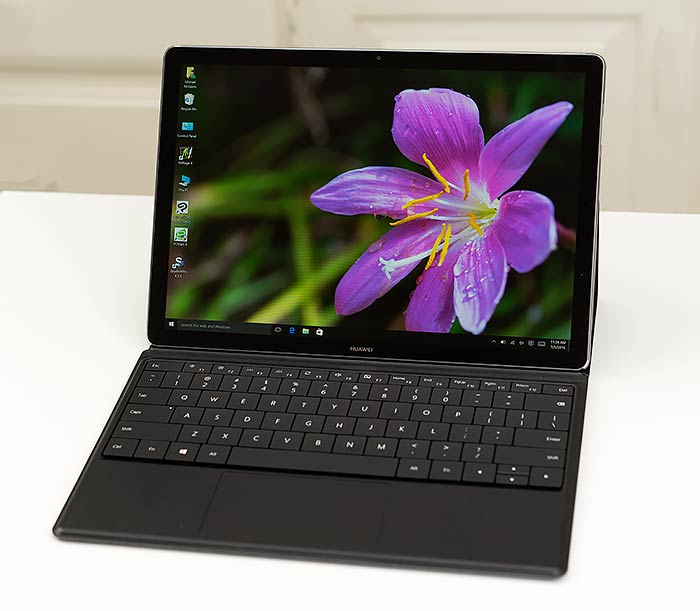
The machine is available with 4 or 8 gigs of DDR3L RAM and your choice of a 128, 256 or 512 gig SATA SSD (right now, in the US RAM amount and SSD capacity are bundled, so it's not a mix and match system). The base model has the Intel Core m3, 4 gigs of RAM and a 128 gig SSD and sells for $699 (tablet only, no keyboard or pen). The Core m5 with 8 gigs of RAM and a 256 gig SSD is $999, which nets you the same config but a faster Core i5 and faster PCIe 128 gig SSD for Surface Pro 4 (there is no higher end, matching configuration for the Galaxy TabPro S). The Core m5 with 8 gigs of RAM and a 512 gig SSD is $1,199 and there's no price at this point for a Core m7, though we've heard that top of the line model might sell for $1,599.
The tablet is sealed with no visible screws, so it's not something you'd want to upgrade yourself at a later date (I suspect one would have to pull the screen to access the internals).
Broadcom dual band WiFi 802.11ac with MIMO and Bluetooth 4.1 are standard, as is a front 5MP camera. There is no rear camera, unlike many other tablets. The MateBook has stereo speakers that are relatively loud for a tablet, but don't expect much bass or lower midrange. Beyond the combo mic/headphone jack, there's a lone USB-C 3.1 Gen. 1 (equivalent in speed to USB 3.0). The charger plugs into this port, so if you wish to use peripherals while charging, you'll need a splitter dongle or Huawei's $89 MateDock that has Ethernet, HDMI, VGA, two USB 3.0 ports and a pass through USB-C port for charging. If you need a DisplayPort, you'll have to look to third party USB-C adapters and docks.
Benchmarks
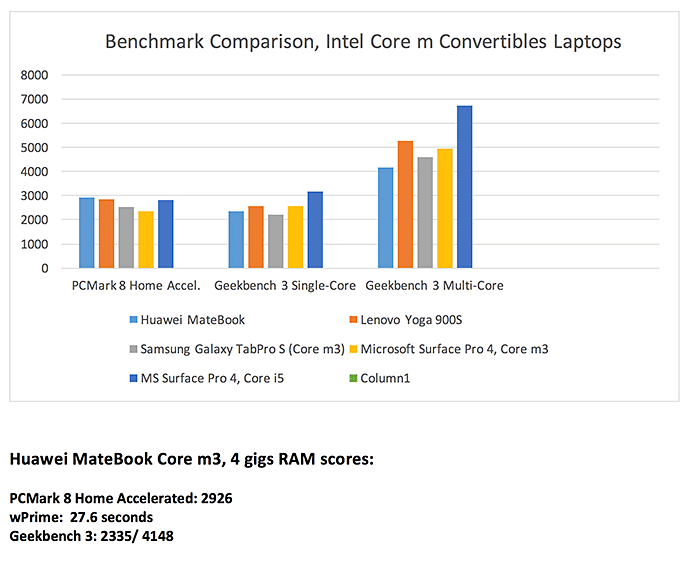
Design and Accessories... Dock and Keyboard
This is a crazy thin and light 12" Windows tablet. It weighs just 1.4 lbs. and is just 6.9mm thick. It looks like a high end piece of technology with slim bezels and a good looking aluminum back. The tablet is rigid and nicely finished from the polished edges to the nicely mated seams. We know from the lovely Nexus 6P Android phone that Huawei can make nice things. It's noticeably thinner than the Surface Pro 4 and similar in size and thickness to the Samsung Galaxy TabPro S. The tablet has a power button up top and volume buttons on the right side. There's a fingerprint scanner nestled between the volume buttons, and it works with Windows Hello for log in.
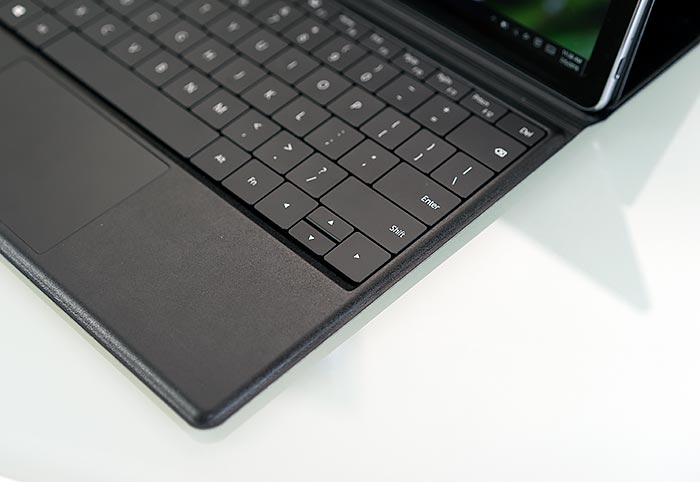
The tablet has just two ports, the headphone jack and a single USB-C port, and that means you'll either want to buy the MateDock or a collection of dongle adapters or other USB-C dock. The $89 MateDock isn't a dock at all, but a small device that houses commonly used ports (other than DisplayPort). It too has a faux leather wrap to match the keyboard portfolio, and the wrap has a pen holder. The tablet is too thin for a pen silo and there's no pen holder on the keyboard case. You can buy USB-C DisplayPort adapters, should you need that monitor connection. Huawei includes both USB-C to USB 3.0 and USB-C to micro USB cables in the box, so you can use traditional USB peripherals without buying an adapter. The micro USB port is handy for connections to smartphones and to charge the optional $59 MatePen.
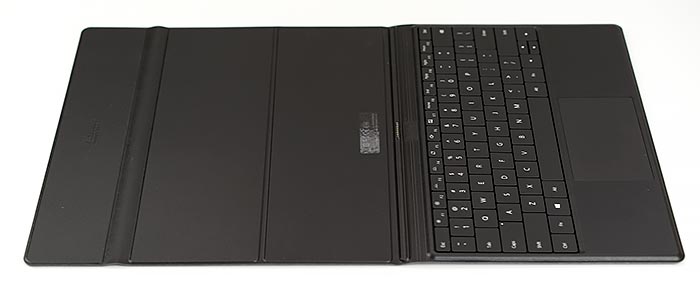
The MateBook has a magnetic pogo pin connector on the bottom for the optional $129 keyboard portfolio that's both a backlit keyboard and a faux leather case (available in black or brown). The keyboard gets power from the pogo connector, so you don't need to charge it. It's a decent keyboard for a tablet accessory, though it flexes and trampolines more than the Surface Type Cover and the Lenovo ThinkPad X1 Tablet keyboard (it's much better than the keyboard folio included with the Samsung Galaxy TabPro S). If you're not a long form writer, you'll probably learn to get along with it. It's backlit in white and is spill and slash resistant. The keys are traditional non-island style keys with no space in between (I'm OK with that), and travel is good at 1.4mm. That said, flex is noticeable and that detracts a bit from the typing experience. It's a decent but not great keyboard.
The keyboard is embedded in a portfolio case that's easy to set up as a stand, but you get just two positions, one very upright and one with a slight tilt away from you. Magnets hold it shut for transit and those magnets will also put the tablet to sleep when you close the portfolio. Unfortunately, they'll also shut it off when you wrap the flap behind the tablet, as you would when handing it to another person to share content. That's a novice mistake on Huawei's part. The portfolio case, like the iPad Pro keyboard case and other competing products, is reasonably stable, though bumpy bus rides might dislodge it.
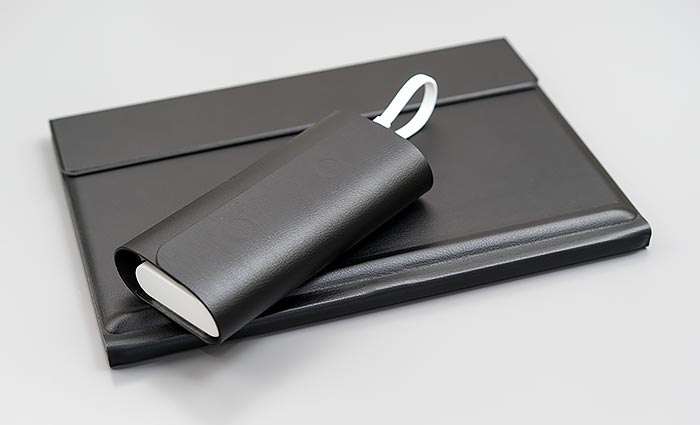
|
|

